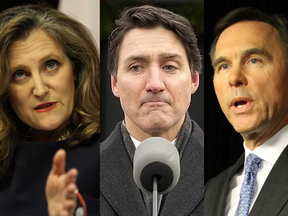Article content
Economists at the National Bank of Canada released a report recently arguing that Canada is caught in a “population trap.” But what exactly does that mean and how does a country get out of it? The Financial Post’s Denise Paglinawan explains.
What is a population trap?
Article content
The Oxford dictionary defines population trap as an economic “situation where no increase in living standards is possible, because the population is growing so fast that all available savings are needed to maintain the existing capital-labour ratio.” In layman’s terms, this means there are so many new people, that all our investment capacity is getting used up incorporating them into the economy and getting them up to speed — there is nothing left over to actually increase the overall standard of living. Stéfane Marion, one of the National Bank economists who authored the report, described a population trap as something akin to a toolbox not big enough to hold all the tools people need. “If you invite three people into the country and you only have two hammers, the third person is lacking capital and can’t be as productive (as the other two),” he said.
Article content
How does this apply to Canada?
The concept of a population trap has historically been the preserve of emerging economies. But Canada’s rapidly rising population, a result of recent immigration policies, appears to be mimicking that effect of high birth rates. Immigration is good for Canada’s potential gross domestic product, said Marion, but “all good things have their limits.”
Canada’s population increased by more than 1.2 million people or 3.2 per cent in 2023, five times higher than the average for nations in the Organisation for Economic Co-operation and Development. The economists said this population growth is extreme relative to the absorptive capacity of the economy, given that the workforce is not aging faster than the OECD average. This absorption challenge is most evident in Canada’s housing market, where the supply deficit reached a new record of only one housing start for every 4.2 people entering the working-age population, compared to the historical average of 1.8 ratio, they said.
What is capital stock?
The economists say Canada lacks the infrastructure and capital stock to adequately absorb current population growth and improve the standard of living. While the housing shortage has attracted the most attention, capital stock includes components of everything from infrastructure, hospitals, schools, machinery, equipment to software. “Given that we’re running a current account deficit in this country, the only way that we can grow our capital stock is to attract foreign capital at the same time,” said Marion.
Article content
Recommended from Editorial
-
Immigration part of solution to housing crisis: minister
-

Income gap of newcomers narrows
-

Population growth risks aggravating housing headaches
How do we get out of a population trap?
The economists said Canadian policymakers should set population goals against the constraint of Canada’s capital stock, which goes beyond the supply of housing. They estimate that to escape this trap, total population growth should not exceed 300,000 to 500,000 a year.
Marion said one solution would be for Canada to match its population growth to growth in foreign capital. “We need to grow investment to match up immigration to make sure that, at the end of the day, we will be able to assess whether we are successful or not (if) the per capita GDP is on an uptrend or a downtrend,” he said.
• Email: dpaglinawan@postmedia.com
Bookmark our website and support our journalism: Don’t miss the business news you need to know — add financialpost.com to your bookmarks and sign up for our newsletters here.
Share this article in your social network
What’s a population trap and how do you get out of it?
2024-01-23 11:00:01







